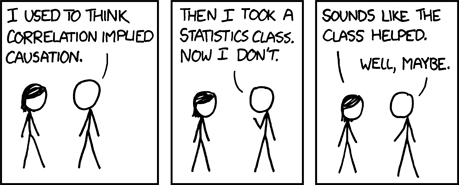Cognitive biases (also known as cognitive distortions) are errors in thinking and judgment that lead to poor decision making. These errors usually happen without us realizing it which makes it difficult to correct them. Learning about cognitive bias can help you notice these errors in your own thinking, as well as others', and can help you make better decisions.
On this page you will find
You can find all of these books (and more!) at CCC library. Ask a librarian if you need help finding them.
There are too many cognitive distortions to list here (see the diagram at the bottom of the page for more examples)  but these are a few of the most common cognitive biases that we engage in on a regular basis. See if you can catch your own brain falling for one of these cognitive distortions.
but these are a few of the most common cognitive biases that we engage in on a regular basis. See if you can catch your own brain falling for one of these cognitive distortions.
Confirmation bias is the tendency to search for, interpret, focus on and remember information in a way that confirms one's preconceptions.
Conservatism bias, the tendency to insufficiently revise one's belief when presented with new evidence.
Curse of knowledge: When better-informed people find it extremely difficult to think about problems from the perspective of lesser-informed people.
Dunning–Kruger effect, the tendency for unskilled individuals to overestimate their own ability and the tendency for experts to underestimate their own ability.
Gambler's fallacy, the tendency to think that future probabilities are altered by past events, when in reality they are unchanged. For example, "I've flipped heads with this coin five times consecutively, so the chance of tails coming out on the sixth flip is much greater than heads."
Groupthink, the psychological phenomenon that occurs within a group of people in which the desire for harmony or conformity in the group results in an irrational or dysfunctional decision-making outcome. Group members try to minimize conflict and reach a consensus decision without critical evaluation of alternative viewpoints by actively suppressing dissenting viewpoints, and by isolating themselves from outside influences.
Illusory correlation: Inaccurately seeing a relationship between two events related by coincidence. (This is what is illustrated in the comic.)
Rhyme as reason effect, where rhyming statements are perceived as more truthful.
Spotlight effect: The tendency to overestimate the amount that other people notice one's appearance or behavior.
Comic is "Correlation" from XKCD by Randall Munroe
People generally believe that they are mostly rational in their thinking, decisions, and actions. But even the smartest and best educated people often commit cognitive errors as they make financial, medical, personal and ethical decisions. These errors in thinking, also called cognitive bias, affect all people in virtually every situation.
Source: Ethics Unwrapped by the University of Texas at Austin
We used to think that the human brain was a lot like a computer; using logic to figure out complicated problems. It turns out, that it’s a lot more complex and, well, weird than that. In this episode of Crash Course Psychology, Hank discusses thinking & communication, solving problems, creating problems, and a few ideas about what our brains are doing up there.
Skip forward to 5:46 in this video to see what Hank has to say about cognitive bias.